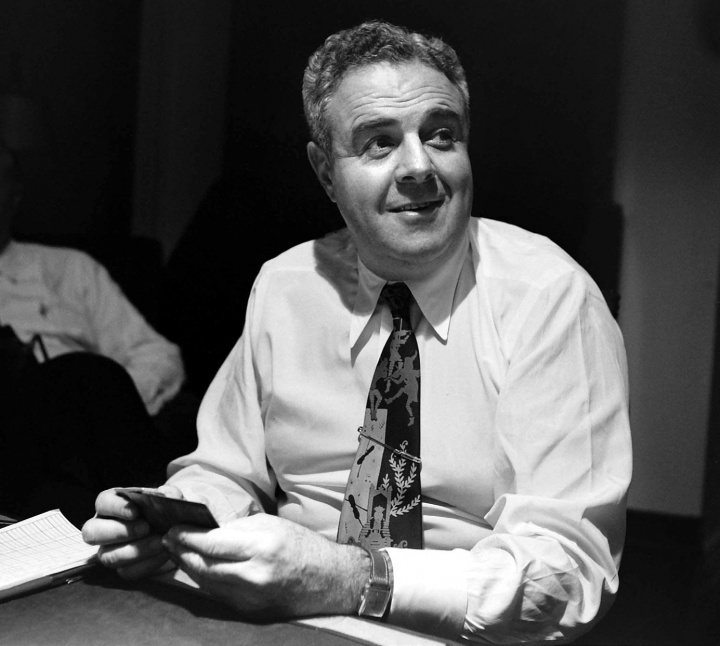Oswald Jacoby CC 1922 was among the best-known gamesters in the world
Columbia College | Columbia University in the City of New York
Oswald Jacoby CC 1922 was among the best-known gamesters in the world

Games king Oswald Jacoby CC 1922 playing canasta in 1949.
MARTHA HOLMES / THE LIFE PICTURE COLLECTION VIA GETTY IMAGES
And what a career it was! When he died in 1984, Jacoby was among the best-known gamesters in the world — poker, backgammon, canasta, whist, chess, pinochle, craps, gin rummy, you name it. With fiendish computational ability, a phenomenal memory and seemingly limitless energy, he could belly up to a green baize table and take you to the cleaners. “There have always been people better than me at some game,” Jacoby told Sports Illustrated in 1978. “But I am still the best player of all games in the world today. There’s no one around who can beat me.”
Jacoby’s specialty was bridge, and his myriad approaches and successes made him a legend. He won 27 North American championships and published more than 10,000 syndicated bridge columns over 34 years. They were required reading for a generation of postwar suburbanites looking to make friends with their new neighbors — veterans and homemakers who barely knew a trump from a dummy.
His statistics speak for themselves. In only four years (1958–62) Jacoby overtook Charles Goren as the bridge world’s leader in master points, as awarded by the American Contract Bridge League. In 1963 he became the first player in history to win more than 1,000 master points in a single game. Four years later he won his 10,000th master point, something never before achieved.
The Brooklyn-born Jacoby was always in a hustling hurry. At 2, he corrected his aunt’s wording of nursery rhymes. During WWI military training (he joined at 15 by lying about his age), he played poker with his fellow grunts. By the time he arrived on campus in 1918, he had won $2,000 — enough to pay many of his College expenses. While still an undergraduate, he triumphed in a chess match against U.S. champion Frank Marshall. At 21, he became the youngest licensed actuary in New York State history, and at 28, he turned full-time gamer.
Jacoby reckoned that his talent for chance and numbers (he could multiply 647,992 by 435,638 in his head) could yield him fame and fortune. He once quoted Horatius Cocles, who heroically defended Rome in 509 B.C.: “How can man die better than facing fearful odds?” Jacoby tartly responded, “It may be a good way to die, but I can’t think of a worse way to gamble.”
Soon enough, Jacoby set his focus on bridge. His timing was perfect. In 1925, Harold Stirling Vanderbilt, of the wealthy Vanderbilt family, devised contract bridge, a variation on the original auction variety. With his new bidding and scoring system, as well as other features, Vanderbilt made an already popular pastime even more compelling and challenging. Contract soon became the bridge standard, and Jacoby seized on the opening. He emerged victorious in many tournaments, making his rep in the 1931–32 Culbertson-Lenz competition, still known as the “Bridge Battle of the Century.” By 1933, Vanity Fair was calling him “one of America’s most brilliant players.”
Jacoby was not merely a superb player; he was also an innovator. He is immortalized with the “Jacoby Transfer,” whereby a lead bidder could strengthen his partner’s weak hand. “He thought up bids for hands that had not been used,” Ronald Haack ’65, a computer programmer turned bridge teacher, told CCT. “He thought up arrays for better suits.” Haack added, “He was famous for being able to tell what was in people’s hands. And the only explanation for that is that he was psychic.”
A lightning-fast competitor, Jacoby was lightning-fast all around. He married Mary Zita McHale a week after meeting her. While he was playing in the National Open Pairs bridge championship in Richmond, Va., on December 7, 1941, the Japanese attacked Pearl Harbor. Jacoby found a substitute, quit the game and enlisted in Naval intelligence to help crack Axis codes. In 1950, when communist troops invaded South Korea, he got a call from Washington, D.C. “We need a computer in the Far East,” the voice on the other end said.
“Buy one,” Jacoby replied.
“We can’t buy one. You’re the one,” said the voice. A week later, Jacoby was a counterintelligence agent in Japan.
In his prime, Jacoby was a cottage industry. His one-dollar book How to Win at Canasta was the fifth best-selling volume of 1949, and he lent his name to a brand of mechanical pencil that was used to record points in that game. His name also adorned a mass-market version of backgammon produced by Pressman Toys. He even lectured at MIT on probability theory. His many admirers spoke of “The Wizardry of Ozzie.”
Indeed, the wizard was also a philosopher — in his case, of the never-ending wagering that is life. “There is no such thing as playing any game for mere joy,” Jacoby said. “If you don’t have something to lose, you tend not to care. It spoils the game.”

Published three times a year by Columbia College for alumni, students, faculty, parents and friends.
Columbia Alumni Center
622 W. 113th St., MC 4530, 6th Fl.
New York, NY 10025
212-851-7852
cct@columbia.edu

Columbia Alumni Center
622 W. 113th St., MC 4530, 4th Fl.
New York, NY 10025
212-851-7488
ccalumni@columbia.edu